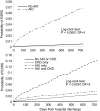Acute kidney injury increases risk of ESRD among elderly
- PMID: 19020007
- PMCID: PMC2615732
- DOI: 10.1681/ASN.2007080837
Acute kidney injury increases risk of ESRD among elderly
Abstract
Risk for ESRD among elderly patients with acute kidney injury (AKI) has not been studied in a large, representative sample. This study aimed to determine incidence rates and hazard ratios for developing ESRD in elderly individuals, with and without chronic kidney disease (CKD), who had AKI. In the 2000 5% random sample of Medicare beneficiaries, clinical conditions were identified using Medicare claims; ESRD treatment information was obtained from ESRD registration during 2 yr of follow-up. Our cohort of 233,803 patients were hospitalized in 2000, were aged > or = 67 yr on discharge, did not have previous ESRD or AKI, and were Medicare-entitled for > or = 2 yr before discharge. In this cohort, 3.1% survived to discharge with a diagnosis of AKI, and 5.3 per 1000 developed ESRD. Among patients who received treatment for ESRD, 25.2% had a previous history of AKI. After adjustment for age, gender, race, diabetes, and hypertension, the hazard ratio for developing ESRD was 41.2 (95% confidence interval [CI] 34.6 to 49.1) for patients with AKI and CKD relative to those without kidney disease, 13.0 (95% CI 10.6 to 16.0) for patients with AKI and without previous CKD, and 8.4 (95% CI 7.4 to 9.6) for patients with CKD and without AKI. In summary, elderly individuals with AKI, particularly those with previously diagnosed CKD, are at significantly increased risk for ESRD, suggesting that episodes of AKI may accelerate progression of renal disease.
Figures


Comment in
-
Yin and Yang: acute kidney injury and chronic kidney disease.J Am Soc Nephrol. 2009 Jan;20(1):8-10. doi: 10.1681/ASN.2008111197. Epub 2008 Dec 31. J Am Soc Nephrol. 2009. PMID: 19118145 No abstract available.
References
-
- Abreo K, Moorthy AV, Osborne M: Changing patterns and outcome of acute renal failure requiring hemodialysis. Arch Intern Med 146: 1338–1341, 1986 - PubMed
-
- Chertow GM, Christiansen CL, Cleary PD, Munro C, Lazarus JM: Prognostic stratification in critically ill patients with acute renal failure requiring dialysis. Arch Intern Med 155: 1505–1511, 1995 - PubMed
-
- Douma CE, Redekop WK, van der Meulen JH, van Olden RW, Haeck J, Struijk DG, Krediet RT: Predicting mortality in intensive care patients with acute renal failure treated with dialysis. J Am Soc Nephrol 8: 111–117, 1997 - PubMed
-
- Parker RA, Himmelfarb J, Tolkoff-Rubin N, Chandran P, Wingard RL, Hakim RM: Prognosis of patients with acute renal failure requiring dialysis: Results of a multicenter study. Am J Kidney Dis 32: 432–443, 1998 - PubMed
-
- Star RA: Treatment of acute renal failure. Kidney Int 54: 1817–1831, 1998 - PubMed
Publication types
MeSH terms
LinkOut - more resources
Full Text Sources
Other Literature Sources
Medical

